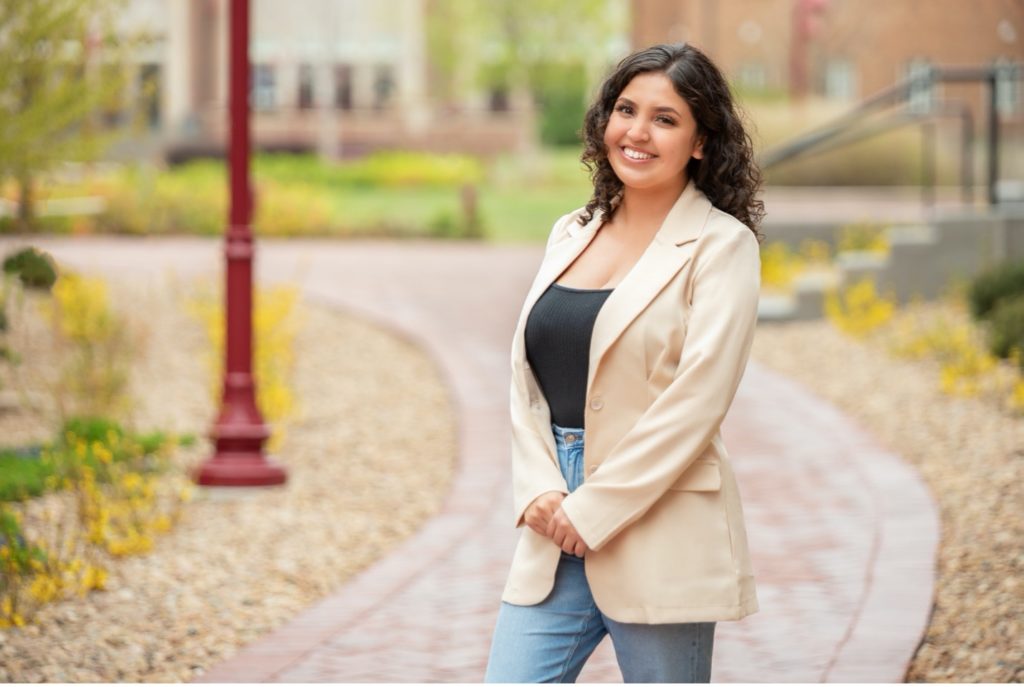by Kamila Kinyon
This spring, we will be publishing a series of spotlight articles about multilingual students at DU. These articles are based on interviews that Kamila Kinyon conducted about students’ memories of becoming multilingual, their connection to their heritage language, and their experiences at DU. This project is funded by a 4D Infusion Grant awarded for 2022-23 to Juli Parrish and Kamila Kinyon. We welcome this opportunity to celebrate DU’s multilingual speakers and writers.
A Davis New Mexico Scholar and long-time activist for immigrant rights, Naomi Perez has an inspiring story to share about her bicultural bilingual heritage and her experience as a first-generation student at DU.
Equally proficient in English and Spanish, Naomi is a senior in Communication Studies and Spanish who is minoring in Writing Practices and Critical Race and Ethnic Studies. She works as Student Mentor to the Dean’s Office: “I meet with a lot of groups, especially groups of students of color who might speak other languages. And I try to focus on how I can better assist these students.” After graduating, she wants to go into social media: “I hope to work with a company who knows and values (multilingualism) and allows me to use my Spanish to reach a broader audience.”
Naomi is an accomplished writer. Her work was featured in the Writing Program’s 2020 Fall Student Showcase, and her autoethnography “From Here and From There” was published in the Writing Program’s magazine WRIT Large. In this autoethnography, Naomi discusses her numerous border crossings. After her grandfather’s death, she traveled to Mexico with her mother, who wasn’t allowed to return to the U.S. Naomi eventually returned alone to further her education and became involved in student activist groups for immigrant rights. Her mother was eventually granted a visa and reunited with her daughter, supporting her in her goals to go to college. Receiving the prestigious Davis New Mexico Scholarship enabled Naomi to come to DU to study.
In an interview with me, Naomi shared her school experiences and shifting perspectives on language. Learning English in her Albuquerque kindergarten was difficult: “I remember being really stressed out all the time, because in kindergarten I didn’t have any friends because I couldn’t talk to anybody.” While there was a Spanish speaking teacher’s assistant who helped her, Naomi relates some setbacks when learning to speak, read, and write English. One unique example relates to spelling her name, which due to her dual citizenship is recorded differently in the U.S. and Mexico: “I would always put an ‘h’ on my name ‘Nahomi’ and my teacher would always correct it and I’m like why is she taking the ‘h’ out of my name.” Despite initial difficulties, she soon came to realize the value of multilingualism. When studying in Mexico, other students wanted her help learning English. When in high school in the U.S., she helped with parent-teacher conferences since many teachers didn’t speak Spanish and many parents didn’t speak English.
When asked about the types and level of support that DU offers to multilingual students, Naomi expressed enthusiasm about the Spanish Program for Heritage Speakers founded by Lina Reznicek-Parrado. This program allows native Spanish speakers to learn at their current level of fluency: “A lot of people learn Spanish at home, but their entire education is in English, so a lot of people will speak Spanish, but they don’t know how to write it well, or they don’t know how to read it well.” Naomi relates that she used to be embarrassed in regular Spanish classes, because her Spanish was too good. DU’s Bilingual Heritage Program provides challenging and meaningful classes.
Naomi gives this final word of advice to other multilingual students: “Don’t be embarrassed to use your language in contexts where nobody else speaks it.

